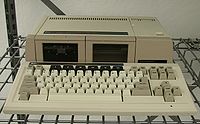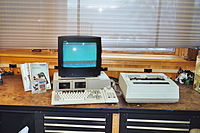- Coleco Adam
-
 Memory console and keyboard from the ColecoVision Expansion Module #3 version of the Coleco Adam, which converts the Colecovision into an Adam computer.
Memory console and keyboard from the ColecoVision Expansion Module #3 version of the Coleco Adam, which converts the Colecovision into an Adam computer.
The Coleco Adam is a home computer, an attempt in the early 1980s by American toy manufacturer Coleco to follow on the success of its ColecoVision game console. The Adam was not very successful, partly because of early production problems.[1]
Contents
Introduction
Coleco announced the Adam in June 1983 at the Summer Consumer Electronics Show (CES) and executives predicted sales of 500,000 by Christmas 1983. From the time of the computer's introduction to the time of its shipment, the price increased, from USD $525 to $725.
The Adam is famous for an incident connected with its showing at the June, 1983 CES. To showcase the machine, Coleco decided to demonstrate a port of its ColecoVision conversion of Donkey Kong on the system. Nintendo was in the midst of negotiating a deal with Atari to license its Famicom for distribution outside of Japan, and the final signing would have been done at CES. Atari had exclusive rights to Donkey Kong for home computers (as Coleco had for game consoles), and when Atari saw that Coleco was showing Donkey Kong on a computer, its proposed deal with Nintendo was delayed. Coleco had to agree not to sell the Adam version of Donkey Kong. Ultimately, it had no bearing on the Atari/Nintendo deal, as Atari's CEO Ray Kassar was fired the next month and the proposal went nowhere, with Nintendo deciding to market its system on its own.
Technical details
In its favor, the Adam had a large software library from the start. It was derived from and compatible with the ColecoVision's software and accessories, and, in addition, the popular CP/M operating system was available as an option. Its price gave a complete system: an 80 kB RAM computer, tape drive, letter-quality printer, and software including the Buck Rogers: Planet of Zoom video game. The IBM PCjr sold for $669 but included no peripherals, and although the popular Commodore 64 sold for around $200, its price was not much lower after the purchase of a printer, tape or disk drive, and software.
Like many home computers of its day, the Adam was intended to use a television set for its display. The SmartWriter electronic typewriter loaded when the system was turned on. In this mode, the system operated just like a typewriter, printing letters as soon as the user typed them. Pressing the Escape/WP key put SmartWriter into word processor mode, which functioned similarly to a modern word processor.
A less expensive version of the Adam plugged into a ColecoVision, which delivered on one of ColecoVision's launch commitments that owners would one day be able to upgrade their game system to a fully featured computer system.
Problems
The Adam was not without weaknesses:
- The Adam generates a surge of electromagnetic energy on startup, which can erase the contents of any removable media left in or near the drive.[2] Making this problem worse, some of the Coleco manuals instructed the user to put the tape in the drive before turning the computer on; presumably these were printed before the issue was known.[2]
- Initial shipments to customers included a high rate of defective tape drives, some say up to 50%.[citation needed] Ejecting a tape while it was moving would usually destroy the drive as there was no eject lock-out mechanism and the tape (based on a standard Compact Cassette) moved at an extremely high speed.
- Since Coleco made the unusual decision of using the printer to supply power to the entire Adam system, if the printer's electronics failed or the printer was missing, none of the system worked.[2]
- Unlike other home computers at the time, the Adam did not have its BASIC interpreter permanently stored in ROM. Instead, it featured a built-in electronic typewriter and word processor, SmartWriter, as well as the Elementary Operating System (EOS) OS kernel and the 8kB OS-7 ColecoVision operating system. The SmartBASIC interpreter was delivered on a proprietary format Digital Data Pack tape cassette.
- Once put into Word Processor mode, SmartWriter could not get back into the typewriter mode without the system being rebooted.
- The Adam's Digital Data Pack drives, although faster and of higher capacity than the audio cassette drives used for competing computers, were less reliable and still not as fast as a floppy disk drive. Coleco eventually shipped a 160K 5¼ inch disk drive for it.
Reception
The Adam received some good reviews based on the quality of its keyboard and printer, and offered competitive sound and graphics. Its BASIC interpreter, called SmartBASIC, was largely compatible with Applesoft BASIC, which meant that many type-in programs from computer books and magazines would work with the Adam with little or no modification.
However, sales were weak, especially after the technical issues became obvious. Coleco lost $35 million in the fourth quarter of 1984 as returns flooded in. Officially, Coleco blamed "manuals which did not offer the first-time user adequate assistance."[3] Coleco reintroduced Adam with a new instruction manual, lower price, and a $500 college scholarship along with each unit for use by a young child (to be paid when the child reached college). Less than 100,000 units ultimately sold. The Adam was discontinued in 1985, less than two years after its introduction.
Legacy
The Adam weakened Coleco by absorbing much of the money it had made from Cabbage Patch Kids; the company filed for bankruptcy in 1988.
A group of Adam enthusiasts gather every year at the annual AdamCon.[4] The 22nd AdamCon was held June 18–20, 2010 in Montreal, Canada. The 23rd AdamCon (AdamCon23) will be held in Grand Rapids, MI from July 14th thru July 17th 2011.[5]
Specifications
- CPU: Zilog Z80[6] @ 3.58 MHz
- Support processors: three Motorola 6801s @ 1 MHz (memory & I/O, tape, and keyboard control)
- Memory: 80 kB RAM, 16 kB video RAM; 32 kB ROM
- Expansion: 3 internal slots, 1 cartridge slot, and a 62.5 kbit/s half-duplex serial bus called AdamNet. The stand-alone also has an external expansion port of the same type as the ColecoVision expansion port, on the right hand side.
- Secondary storage: Digital Data Pack tape cassette, 256 kB
- Graphics: Texas Instruments TMS9928A (a close relative of the TMS9918 in the TI-99/4A)
- 256 × 192 resolution
- 32 sprites
- Sound: Texas Instruments SN76489AN
- 3 voices
- white noise
References
- ^ Woutat, Donald (January 3, 1985). "Coleco Discontinues Its Adam Computer Line". LA Times. http://articles.latimes.com/1985-01-03/business/fi-11281_1. Retrieved 2010-08-26.
- ^ a b c Bateman, Selby and Halfhill, Tom R. (1984). "Coleco's Adam: A Hands-On Report". Compute! Magazine. http://www.atarimagazines.com/compute/issue46/023_1_Colecos_Adam_A_Hands-On_Report.php. Retrieved April 29, 2007.
- ^ Greenwald, John (1984-06-18). "How Does This". Time Magazine. http://www.time.com/time/magazine/article/0,9171,951198,00.html?promoid=googlep. Retrieved April 29, 2007.
- ^ AdamCon - Coleco Adam Convention News and Adam News Archives
- ^ [1]
- ^ InfoWorld (Vol. 6, Num. 17): 66. 23 April 1984. ISSN 0199-6649.
External links
- Coleco Adam Technical Reference Manual (Coleco Industries, Inc., 1984)
- Coleco ADAM Schematics (in PDF format; restored and unrestored)
- Video Game Nostalgia's Adam page
- Expandable Computer News Archive
- ADAM article at The Dot Eaters, an extensive history of Coleco and the ADAM
- www.old-computers.com Coleco Adam's page
- Adamcon home page
- Oldcomputers.net's Adam page has some nice photos of components
- Video of Coleco ADAM
Categories:- Home computers
Wikimedia Foundation. 2010.

